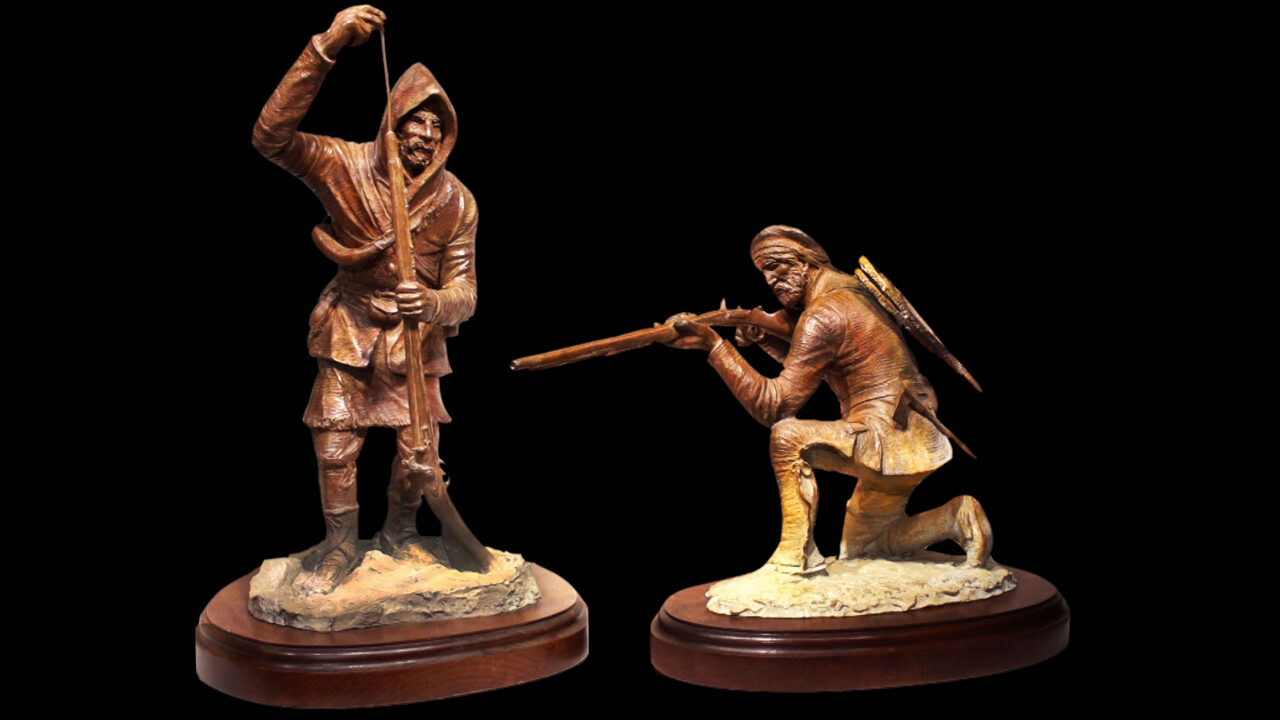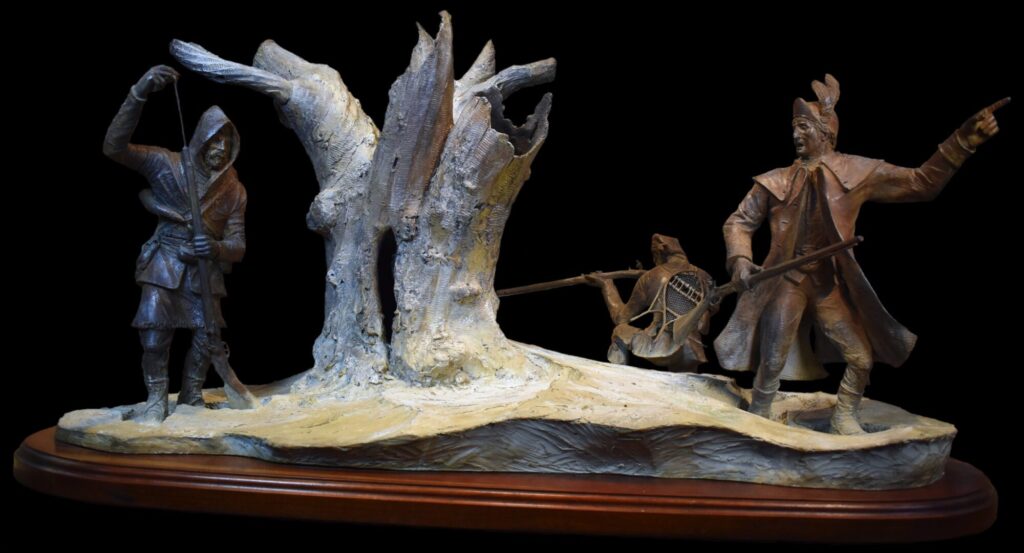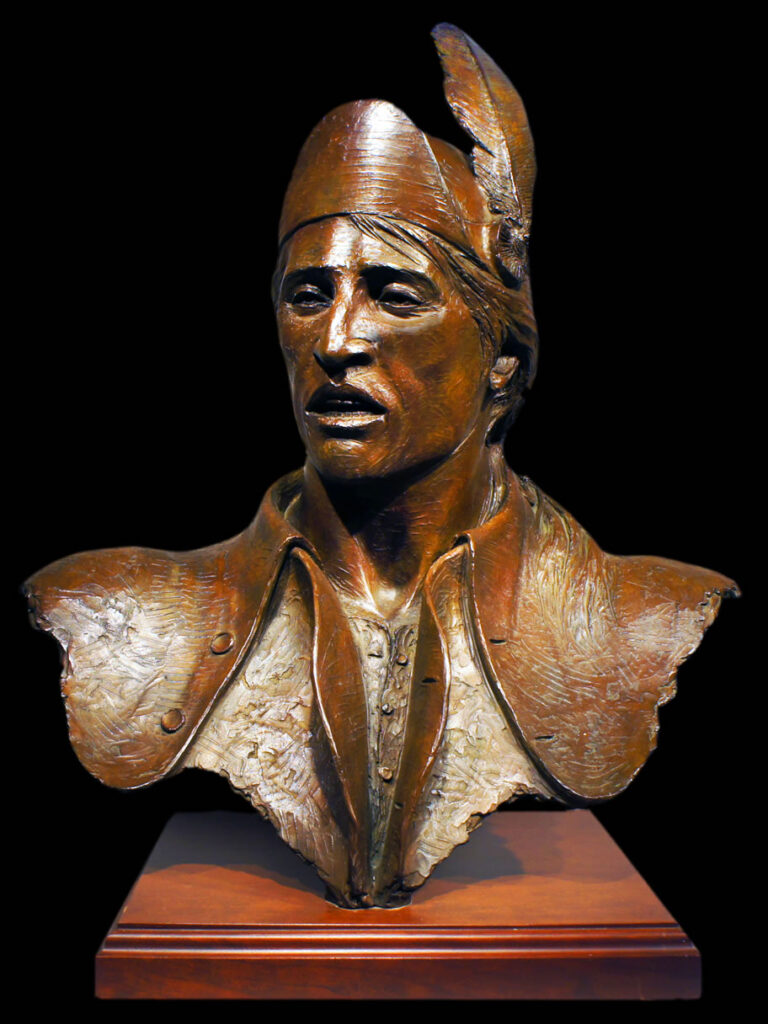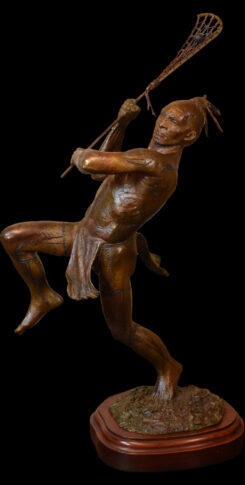THE RANGER | Bonze edition: 25 | Height: 22″
THE MARKSMAN | Bronze edition: 25 | Height: 15″
Sold as a set or may be purchased separately
The “Battle on Snowshoes” was one of the most famous battles of the French and Indian War. Rogers turns one of his only defeats into a “victory” through clever public relations and by exaggerating both of the enemies’ strength and the number of casualties inflicted. He thus further enhances his already legendary reputation. His nemesis is the most famous of the Canadian partisan fighters the Sieur Jean-Baptiste Leverault de Langis de Montegron (a.k.a. Langy).
March 1758: Rogers leads 180 rangers on a scout north toward Ft. Carillon (Ticonderoga) behind enemy lines. There are 4′ of snow on the ground. Along the west side of Bald Mountain near Lake George, they discover below them a force of about 100 Indians and a few French under the command of the Sieur de la Durantaye heading south on the frozen Trout Brook. The Rangers open fire killing about 40 of the enemy. They pursue them back up the brook but run headlong into the musket fire of Langy’s more than 200 men. Up until this terrible awakening, they were unaware of Langry’s force. They were caught completely by surprise. The withering fire and savage counter attack leaves 50 Rangers dead. Rogers shouts orders to fall back to higher ground. The battle now rages for 90 minutes until dusk when, just before they are completely surrounded, Rogers orders the survivors to scatter and meet at the agreed upon rendezvous place. Accounts vary but no more than 35-55 of the original 181 Rangers survive. The French will claim 145 scalps taken. Carillon’s commandant Hebecourt reports: “We had a wonderful result but it cost us dearly through the loss that we suffered.”
The Ranger
Typically most early ranger recruits were of Scots-Irish descent and lived along the New England frontier generally described as “all lusty, stout men, six feet high.” In 1756 Governor Shirley issued Robert Rogers a commission to command an independent company of rangers. He was ordered “to enlist none but such as were used to traveling and hunting, and in whose courage and fidelity I could confide.” Later as the number of ranger companies increased, the ethnic make-up went from primarily Scots-Irish and English to include: Irish, Welsh, Dutch, German, Spanish or Portuguese (the later often former sailors). There were also black rangers, some free men others servants and three of the 1759 ranger companies were made up entirely of Indian allies of the British (i.e. Stockbridge (Mahican), Pequot and Mohegan).
The Rangers never enjoyed a consistent uniform pattern though green was their color of preference. In the field they often resembled Indians, exhibiting a “cut-throat savage appearance.” To Scots Highlander Capt. James Abercrombie, despite their sometimes wild exterior, they looked the very essence of true soldiers. “I was so pleased with them that I took it for granted they would behave well whenever they met the enemy.”
Among the many perils facing a ranger assigned to winter scouts in the Adirondack Mountains were temperatures reading -40 degrees Fahrenheit, snow blindness, bleeding feet, hypothermia, frostbite, gangrene, lost fingers, toes and noses. Ranger survival skills often underwent severe tests as in the return from their successful attack of the Abenaki village of St. Francis in late fall of 1759 (refer to “Northwest Passage” by Kenneth Roberts, 1935). Provisions grew scarce while being pursued by a vengeful enemy. Often forced to subsist on beech leaves and tree bark, “we were obliged,” wrote volunteer Robert Kirk of the 77th Highland regiment, “to scrape under the snow for acorns and even to eat our shoes and belts, and broil our powder horns and thought it delicious eating.”
The Marksman
The heavy emphasis on marksmanship paid off in their frequent successes against the French and Indians. Even in this their only large scale defeat, the sharpshooting of the heavily outnumbered rangers held off the encircling enemy for 90 minutes. Over two dozen Indians alone were killed and wounded including one of their war chiefs. This was an unusually high casualty rate for the natives “who are not accustomed to lose” (General Montcalm, 1758). So enraged were the Indians that they summarily executed a like number of rangers who had surrendered on the promise of good quarter near the close of the battle on snowshoes.
Captain Henry Pingle based at Fort Edward, observed that the typical ranger recruit could “shoot amazingly well.” In December, 1757, Pringle wrote, one ranger officer “the other day at four shots with four balls, killed a brace of deer, a pheasant and a pair of wild ducks-the later killed at one shot … there are no better marksmans in the world for their whole delight is shooting at marks for wages.”







